Graham is an unrepentantly English name for an exquisitely English watch. If you're interested in the minutiae of watch making, Graham was the surname of George Graham, born in 1673, master watchmaker who lived in Fleet Street in London.
London was definitely the place to be if you were interested in watch making in the 17th and 18th centuries. A highly developed city, it had a business culture, the world's first scientific society and a navy all of which had pressing time keeping requirements.
Like many Brits before and after him, Graham was more interested in generating lots of ideas than in making money. He created several inventions but never patented any of them.
For example, he created the first stopwatch. He devised a mercury pendulum system for making clocks more accurate in very hot and very cold weather. He also invented the dead-beat escapement which made clocks more accurate in general and built the master clock for Greenwich Royal Observatory. The escapement he invented is today simply known as the Graham Escapement and still used in high-precision pendulum clocks. It is actually a predecessor to the Swiss anchor escapement almost universally used in wristwatches.

Graham had a pretty open attitude to sharing his innovations. He often helped fellow horologists like John Harrison and Julien Le Roy to solve problems, and for this acquired the nickname “honest George.
George Graham had learnt his trade from Henry Aske and went on to work for Thomas Tompion. Graham and Tompion moved from being colleagues to friends, with George marrying Tompion's niece, Elizabeth. In 1713, after Tompion's death, Graham took over the business premises.
London had a business culture, the world's first scientific society and a navy all of which had pressing time keeping requirements.
Graham became a veritable pillar of the scientific and clockmaking establishment and in 1721, he was elected as a Fellow of the Royal Society and contributed over twenty papers to its scientific journal, the Philosophical Transactions. George Graham became Master of the Clockmakers' Company in 1722.
George Graham produced nearly three thousand watches during his lifetime. His watches were frequently forged even then, but these fakes are easy to spot. Graham fastidiously inscribed the serial number and his name not only on the back plate (the usual place), but also on the pillar-plate, under the dial, and on the under-side of the bridge. Graham died in 1751 and was buried in Westminster Abbey in the same grave as his mentor and friend, Thomas Tompion. The inscription of the stone reads:
George Graham of London, watchmaker and F.R.S. whose curious inventions do honour to ye British genius whose accurate performance are ye standard of mechanic skill. He died ye XVI of November MDCCLI in the LXXVIII year of his age.
George Graham's curious inventions are the inspiration behind our watches.
GRAHAM WATCHES.
THEY CONFORM TO THE TIME. BUT THAT'S IT.
Our engineers, designers and watchmakers create a form of mechanical perfection that doesn't look or feel like just another Swiss watch. One that has its own quirky way of doing things.
And indeed, our watches have a certain confidence about them. They're not shy and retiring. They've got big movements, big features, big pushers and slightly bigger hands than most.
We use mechanisms and materials in a slightly different way. For example, the trigger mechanism that starts the stopwatch, the use of ceramic and carbon fibre. We only use chronometer quality movements.
We go to slightly potty lengths to create a shock resistant Tourbillion. Our watch wearers don't spend their lives gardening. They do stuff and that means grief for a watch mechanism.
We devote years to cracking problems like that. George Graham would have been proud.





